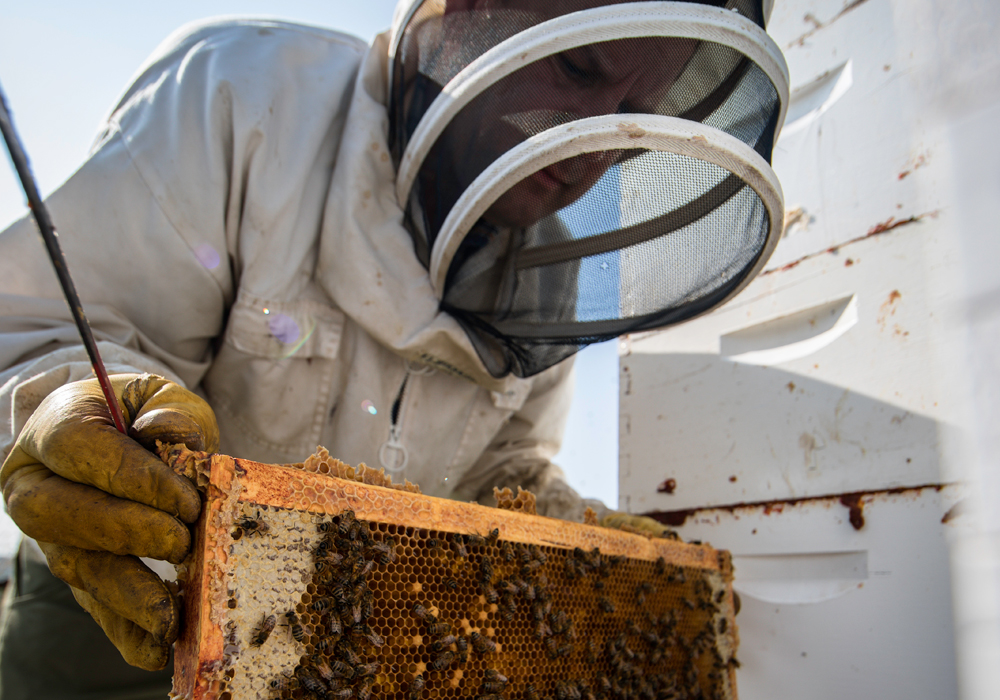Beekeepers across the Prairies are seeing below average honey production this year, so much so that many in Alberta face significant or total crop losses.
Honey production statistics aren’t yet available, but producers and representatives in Alberta say this has been the worst season they’ve seen in 50 years.
“This is all anecdotal, but what we are hearing from beekeepers is production is 50 percent of what they would normally expect, or they might have total crop failure,” said Connie Phillips, executive director of the Alberta Beekeepers Commission.
Read Also

Farming Smarter receives financial boost from Alberta government for potato research
Farming Smarter near Lethbridge got a boost to its research equipment, thanks to the Alberta government’s increase in funding for research associations.
“It’s very stressful, and over the long run it’ll have an economic impact on the farm. It’s their primary source of revenue.”
Alberta beekeepers say reasons for low production this year are largely weather related.
The cold winter last year killed off more hives than normal, which was followed by cool and wet temperatures that slowed bee activity in central and northern Alberta.
In southern Alberta, hot and dry temperatures eliminated forages for bees much sooner, said Phillips, which would reduce honey output.
“Some will take their losses and hope for a better season next year,” she said. “Others might not be able to recover, so they will have to get out of the business.”
Richard Ozero, a beekeeper in the Edmonton region, said he’s seeing empty barrels that should be full of honey.
For him, smoke in the spring, as well as wet and cool temperatures, produced immature flowers. Because of this, he said, the bees couldn’t build up enough strength or access needed food.
“I’m not trying to be all doom-and-gloom, but it’s starting to look a lot more dire,” he said. “I hope there is something that happens, a miraculous turn of events with weather, but I don’t think there is enough time to see that.”
In Saskatchewan, it appears some beekeepers are experiencing losses but not nearly as significant as Alberta.
Simon Lalonde, president of the Saskatchewan Beekeepers Development Commission, said production is looking to be 70 to 80 percent of normal for most people.
“It’s definitely not as bad as Alberta, but it’s not a good year,” he said. “It’s hard to say what the impact is going to be in the next while because we are waiting for production numbers and prices.”
Manitoba is also experiencing challenges.
Daryl Wright, secretary of the Manitoba Beekeepers’ Association and a honey producer near Winnipeg, said production is a mixed bag.
He said the south-central regions are average to above average, while the northwest is seeing below average production. In the southwest, he said, production is below average or average.
“It’s really weather related,” he said. “In drier conditions, flowers aren’t blooming as well.”
In British Columbia, provincial officials are gathering honey production numbers and couldn’t provide anecdotal information.
However, the last few years have been challenging for beekeepers across Canada.
In 2016, Ozero said, adulterated honey began entering the market, pushing down prices for Canadian producers.
Following that, drought years and hard winters negatively affected production. Prices still remain relatively low.
“It’s been year after year with one problem after the other, especially with world prices being below average and below production costs,” he said.
Lalonde also noted challenges over the past couple of years, saying he’s noticed more farms for sale, particularly ones owned by younger operators.
“Usually it’s the guys who’ve been doing it for 60 years that are selling, but now we are starting to see younger, well-established farms being sold,” he said. “Nobody has funds to pay the actual market value for them.”
Phillips said the Alberta Beekeepers Commission has requested a meeting with the provincial agriculture ministry to discuss possible solutions to mitigate losses.
They are weighing whether they should request financial assistance from the province, but getting dollars is unlikely given Alberta’s dismal finances.
However, she said Alberta’s risk management programs for honey production must be reviewed.
“From what I’ve heard, they don’t serve beekeepers well,” she said.
Ozero said insurance programs are in place but they aren’t popular and beekeepers generally haven’t needed them.
He said beekeepers normally buy more hives every year to manage risk, levelling out potential losses, rather than paying into the program.
In Saskatchewan, Lalonde said beekeepers worked with the province to develop a mortality insurance program.
He said about one-third of beekeepers are enrolled in the program. He expects participation would be higher if honey prices were better.
Going forward, it isn’t yet entirely clear how this year’s potential shortfall will affect the overall Canadian honey supply and prices.
Derrick Johnston, senior manager for bee supplies and member relations with BeeMaid’s Alberta honey co-operative, said it is not yet a disaster.
He said BeeMaid, which is made with 100 percent Canadian honey, should have enough carryover stock for customers, but the company will still be affected.
“We are in tough this year, but time will tell in terms of where we will actually fit,” he said.


















